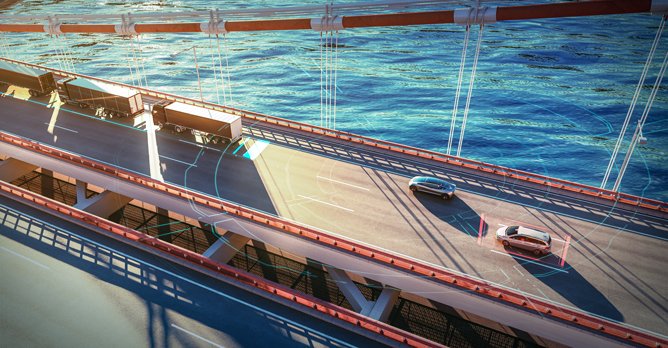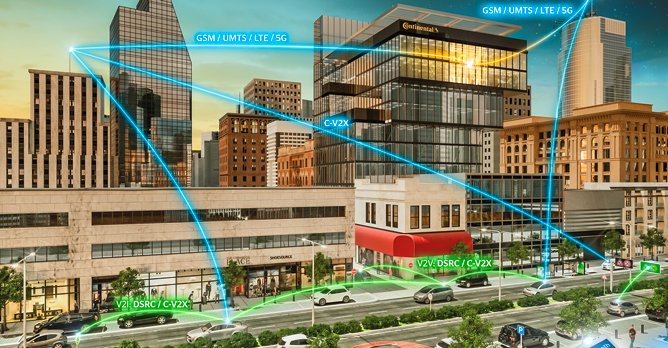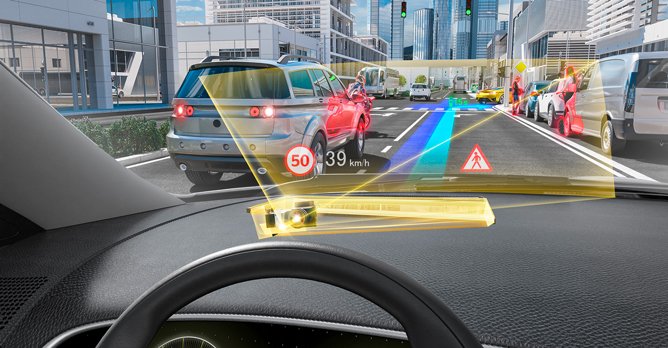Artificial intelligence and augmented reality will be part of the UX in future cars
03 Oct 2022|4,584 views
Driving makes up the bulk of our interactions with our car. We load things in the boot and ferry family members. We become accustomed to how our cars accelerate, brake, steer and corner.
Now, in case you haven't realised it yet, an equally large part of how we interact with our vehicles also happens via two interfaces - the instrument panel and infotainment system. And an increasing number of new cars today feature digital screens for the former.
Buttons and dials have given way to touchscreens, gestures and voice commands. The user experience (UX) has changed, and continues to evolve.
To learn more about the future of in-car UX, we spoke to Philipp von Hirschheydt, head of the User Experience business area and Member of the Automotive Board at Continental. Phillipp talks about how he came to the job, tells us his favourite UX innovations, and discusses the technologies we can look forward to.
Your background is in finance and business administration. How did you end up in the UX division?
One of my first responsibilities at Continental was being the project lead for acquiring Siemens VDO. Later, I was asked to be project lead for integrating Siemens VDO with Continental Automotive.
After that, I worked in areas related to petrol and diesel pumps. Lots of things are linked to management, especially with how you lead organisations and deal with human capital.
Nowadays, the world is so complex that no-one knows everything. You need to harness a team with a collaborative leadership and working style to bring different facets of knowledge together and orchestrate different geniuses.
By orchestrating, you can then produce complex things. I cannot, on my own, produce the new display for an upcoming car. I need to ask my experts. I will help them organise the right resources, and ensure they are being supported, so we can have an end-to-end value chain in the organisation.
My job is to be the 'conductor' of the orchestra.
In-car user-experience (UX) has grown from knobs and buttons to touchscreens, gestures and voice. Where is UX heading next?
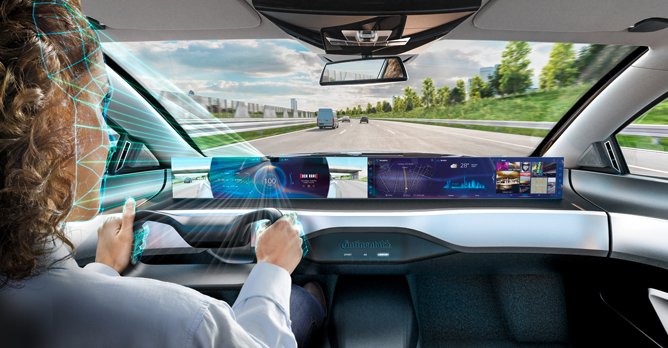
 More advanced AI will enable in-car systems to monitor the driver's condition and make suggestions based on it You will use an even greater mixture of both. But the next step, really, is artificial intelligence (AI). Cabin sensing, or the car's systems sensing what's going on with the driver, is one such application of AI.
More advanced AI will enable in-car systems to monitor the driver's condition and make suggestions based on it You will use an even greater mixture of both. But the next step, really, is artificial intelligence (AI). Cabin sensing, or the car's systems sensing what's going on with the driver, is one such application of AI.
Let's say the system detects that your blood pressure is going down. Imagine the system then asking you if you want to stop at a petrol kiosk to buy a Coke.
How can we extrapolate your needs and desires into a suggestion? This is what we're looking at now.
Are Continental engineers working on this?
We are also working towards AI that can for instance, ask follow-up questions to your requests. Let's say you tell the car you are hungry and ask it to find a Korean restaurant. The system can then ask, 'How long are you willing to drive?'
Digital displays are getting larger and screens have 'taken over' car interiors. Are consumers pushing back?
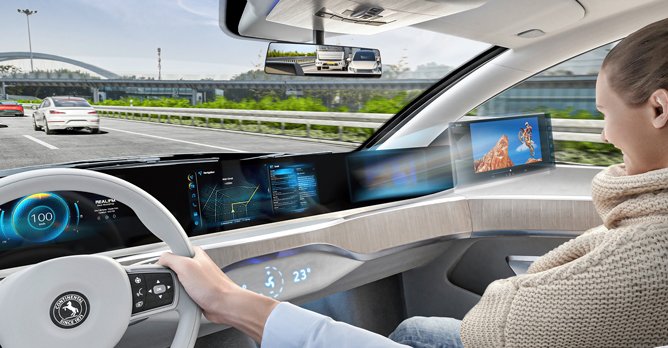
 Switchable Privacy enables the driver to concentrate on driving while allowing the passenger to say, enjoy a movie It can be a distraction, and for some people, too much. That's why we have switchable privacy - displays that can be switched off or partially switched off, for example, when the co-driver watches a video.
Switchable Privacy enables the driver to concentrate on driving while allowing the passenger to say, enjoy a movie It can be a distraction, and for some people, too much. That's why we have switchable privacy - displays that can be switched off or partially switched off, for example, when the co-driver watches a video.
This is where our idea for Shy Display Technology emerged. Shy Display Technology reduces information to what matters so that the driver does not feel overloaded.
From a technical standpoint, how recyclable are these LED displays?
Obviously, this is something that needs to be worked on. Re-using the components is easier than recycling them, for sure.
The answer is clear: We need to live, produce and work much more sustainably. There is no question about that.
For fully autonomous vehicles to become a reality, how would peoples’ interactions with the technology have to change?
In terms of limiting factors for autonomous mobility, I think what we have all underestimated is the amount of computing power required to predict specific situations.
Good or bad, human beings are still unpredictable. Whether a pedestrian runs out into the street or not, is from a recognition point of view, difficult to predict.
Hence for now, the slower your vehicle is, the more you are able to execute autonomous driving.
Connected apps that let you turn on the engine and/or air-con work well if the car is parked outdoors, but not when it’s under shelter. How can this improve?
The use of 5G will definitely help, as it offers better connectivity given the amount of data that has to be sent. Given how 5G is being widely adopted, it’s just a matter of time before this gets better.
What are your favourite UX breakthroughs?
Switchable Privacy is definitely one. It’s something that Continental has started to launch.
It allows everyone to have their own 'atmosphere' based on what they want to do. For instance, one passenger wants to watch a video or work, while the other wants to relax. Switchable Privacy lets you do that.
Do you see augmented reality becoming more popular?
That's going to be the next big thing. It is not tomorrow, and maybe not even in the next 18 months, because it's not easy to implement. This is why thus far, you've only seen 'simple' applications, such as arrows superimposed on the camera feed for navigation.
What were your favourite cars growing up?
I come from the countryside - I was raised in small village, so we always had crossovers or SUVs.
What was the first car you ever drove?
It was my father's Lada Niva, an off-roader.
Now, in case you haven't realised it yet, an equally large part of how we interact with our vehicles also happens via two interfaces - the instrument panel and infotainment system. And an increasing number of new cars today feature digital screens for the former.
Buttons and dials have given way to touchscreens, gestures and voice commands. The user experience (UX) has changed, and continues to evolve.
To learn more about the future of in-car UX, we spoke to Philipp von Hirschheydt, head of the User Experience business area and Member of the Automotive Board at Continental. Phillipp talks about how he came to the job, tells us his favourite UX innovations, and discusses the technologies we can look forward to.
Your background is in finance and business administration. How did you end up in the UX division?
One of my first responsibilities at Continental was being the project lead for acquiring Siemens VDO. Later, I was asked to be project lead for integrating Siemens VDO with Continental Automotive.
After that, I worked in areas related to petrol and diesel pumps. Lots of things are linked to management, especially with how you lead organisations and deal with human capital.
Nowadays, the world is so complex that no-one knows everything. You need to harness a team with a collaborative leadership and working style to bring different facets of knowledge together and orchestrate different geniuses.
By orchestrating, you can then produce complex things. I cannot, on my own, produce the new display for an upcoming car. I need to ask my experts. I will help them organise the right resources, and ensure they are being supported, so we can have an end-to-end value chain in the organisation.
My job is to be the 'conductor' of the orchestra.
In-car user-experience (UX) has grown from knobs and buttons to touchscreens, gestures and voice. Where is UX heading next?

Let's say the system detects that your blood pressure is going down. Imagine the system then asking you if you want to stop at a petrol kiosk to buy a Coke.
How can we extrapolate your needs and desires into a suggestion? This is what we're looking at now.
Are Continental engineers working on this?
We are also working towards AI that can for instance, ask follow-up questions to your requests. Let's say you tell the car you are hungry and ask it to find a Korean restaurant. The system can then ask, 'How long are you willing to drive?'
Digital displays are getting larger and screens have 'taken over' car interiors. Are consumers pushing back?

This is where our idea for Shy Display Technology emerged. Shy Display Technology reduces information to what matters so that the driver does not feel overloaded.
From a technical standpoint, how recyclable are these LED displays?
Obviously, this is something that needs to be worked on. Re-using the components is easier than recycling them, for sure.
The answer is clear: We need to live, produce and work much more sustainably. There is no question about that.
For fully autonomous vehicles to become a reality, how would peoples’ interactions with the technology have to change?
In terms of limiting factors for autonomous mobility, I think what we have all underestimated is the amount of computing power required to predict specific situations.
Good or bad, human beings are still unpredictable. Whether a pedestrian runs out into the street or not, is from a recognition point of view, difficult to predict.
Hence for now, the slower your vehicle is, the more you are able to execute autonomous driving.
Connected apps that let you turn on the engine and/or air-con work well if the car is parked outdoors, but not when it’s under shelter. How can this improve?
The use of 5G will definitely help, as it offers better connectivity given the amount of data that has to be sent. Given how 5G is being widely adopted, it’s just a matter of time before this gets better.
What are your favourite UX breakthroughs?
Switchable Privacy is definitely one. It’s something that Continental has started to launch.
It allows everyone to have their own 'atmosphere' based on what they want to do. For instance, one passenger wants to watch a video or work, while the other wants to relax. Switchable Privacy lets you do that.
Do you see augmented reality becoming more popular?
That's going to be the next big thing. It is not tomorrow, and maybe not even in the next 18 months, because it's not easy to implement. This is why thus far, you've only seen 'simple' applications, such as arrows superimposed on the camera feed for navigation.
What were your favourite cars growing up?
I come from the countryside - I was raised in small village, so we always had crossovers or SUVs.
What was the first car you ever drove?
It was my father's Lada Niva, an off-roader.
Driving makes up the bulk of our interactions with our car. We load things in the boot and ferry family members. We become accustomed to how our cars accelerate, brake, steer and corner.
Now, in case you haven't realised it yet, an equally large part of how we interact with our vehicles also happens via two interfaces - the instrument panel and infotainment system. And an increasing number of new cars today feature digital screens for the former.
Buttons and dials have given way to touchscreens, gestures and voice commands. The user experience (UX) has changed, and continues to evolve.
To learn more about the future of in-car UX, we spoke to Philipp von Hirschheydt, head of the User Experience business area and Member of the Automotive Board at Continental. Phillipp talks about how he came to the job, tells us his favourite UX innovations, and discusses the technologies we can look forward to.
Your background is in finance and business administration. How did you end up in the UX division?
One of my first responsibilities at Continental was being the project lead for acquiring Siemens VDO. Later, I was asked to be project lead for integrating Siemens VDO with Continental Automotive.
After that, I worked in areas related to petrol and diesel pumps. Lots of things are linked to management, especially with how you lead organisations and deal with human capital.
Nowadays, the world is so complex that no-one knows everything. You need to harness a team with a collaborative leadership and working style to bring different facets of knowledge together and orchestrate different geniuses.
By orchestrating, you can then produce complex things. I cannot, on my own, produce the new display for an upcoming car. I need to ask my experts. I will help them organise the right resources, and ensure they are being supported, so we can have an end-to-end value chain in the organisation.
My job is to be the 'conductor' of the orchestra.
In-car user-experience (UX) has grown from knobs and buttons to touchscreens, gestures and voice. Where is UX heading next?

 More advanced AI will enable in-car systems to monitor the driver's condition and make suggestions based on it You will use an even greater mixture of both. But the next step, really, is artificial intelligence (AI). Cabin sensing, or the car's systems sensing what's going on with the driver, is one such application of AI.
More advanced AI will enable in-car systems to monitor the driver's condition and make suggestions based on it You will use an even greater mixture of both. But the next step, really, is artificial intelligence (AI). Cabin sensing, or the car's systems sensing what's going on with the driver, is one such application of AI.
Let's say the system detects that your blood pressure is going down. Imagine the system then asking you if you want to stop at a petrol kiosk to buy a Coke.
How can we extrapolate your needs and desires into a suggestion? This is what we're looking at now.
Are Continental engineers working on this?
We are also working towards AI that can for instance, ask follow-up questions to your requests. Let's say you tell the car you are hungry and ask it to find a Korean restaurant. The system can then ask, 'How long are you willing to drive?'
Digital displays are getting larger and screens have 'taken over' car interiors. Are consumers pushing back?

 Switchable Privacy enables the driver to concentrate on driving while allowing the passenger to say, enjoy a movie It can be a distraction, and for some people, too much. That's why we have switchable privacy - displays that can be switched off or partially switched off, for example, when the co-driver watches a video.
Switchable Privacy enables the driver to concentrate on driving while allowing the passenger to say, enjoy a movie It can be a distraction, and for some people, too much. That's why we have switchable privacy - displays that can be switched off or partially switched off, for example, when the co-driver watches a video.
This is where our idea for Shy Display Technology emerged. Shy Display Technology reduces information to what matters so that the driver does not feel overloaded.
From a technical standpoint, how recyclable are these LED displays?
Obviously, this is something that needs to be worked on. Re-using the components is easier than recycling them, for sure.
The answer is clear: We need to live, produce and work much more sustainably. There is no question about that.
For fully autonomous vehicles to become a reality, how would peoples’ interactions with the technology have to change?
In terms of limiting factors for autonomous mobility, I think what we have all underestimated is the amount of computing power required to predict specific situations.
Good or bad, human beings are still unpredictable. Whether a pedestrian runs out into the street or not, is from a recognition point of view, difficult to predict.
Hence for now, the slower your vehicle is, the more you are able to execute autonomous driving.
Connected apps that let you turn on the engine and/or air-con work well if the car is parked outdoors, but not when it’s under shelter. How can this improve?
The use of 5G will definitely help, as it offers better connectivity given the amount of data that has to be sent. Given how 5G is being widely adopted, it’s just a matter of time before this gets better.
What are your favourite UX breakthroughs?
Switchable Privacy is definitely one. It’s something that Continental has started to launch.
It allows everyone to have their own 'atmosphere' based on what they want to do. For instance, one passenger wants to watch a video or work, while the other wants to relax. Switchable Privacy lets you do that.
Do you see augmented reality becoming more popular?
That's going to be the next big thing. It is not tomorrow, and maybe not even in the next 18 months, because it's not easy to implement. This is why thus far, you've only seen 'simple' applications, such as arrows superimposed on the camera feed for navigation.
What were your favourite cars growing up?
I come from the countryside - I was raised in small village, so we always had crossovers or SUVs.
What was the first car you ever drove?
It was my father's Lada Niva, an off-roader.
Now, in case you haven't realised it yet, an equally large part of how we interact with our vehicles also happens via two interfaces - the instrument panel and infotainment system. And an increasing number of new cars today feature digital screens for the former.
Buttons and dials have given way to touchscreens, gestures and voice commands. The user experience (UX) has changed, and continues to evolve.
To learn more about the future of in-car UX, we spoke to Philipp von Hirschheydt, head of the User Experience business area and Member of the Automotive Board at Continental. Phillipp talks about how he came to the job, tells us his favourite UX innovations, and discusses the technologies we can look forward to.
Your background is in finance and business administration. How did you end up in the UX division?
One of my first responsibilities at Continental was being the project lead for acquiring Siemens VDO. Later, I was asked to be project lead for integrating Siemens VDO with Continental Automotive.
After that, I worked in areas related to petrol and diesel pumps. Lots of things are linked to management, especially with how you lead organisations and deal with human capital.
Nowadays, the world is so complex that no-one knows everything. You need to harness a team with a collaborative leadership and working style to bring different facets of knowledge together and orchestrate different geniuses.
By orchestrating, you can then produce complex things. I cannot, on my own, produce the new display for an upcoming car. I need to ask my experts. I will help them organise the right resources, and ensure they are being supported, so we can have an end-to-end value chain in the organisation.
My job is to be the 'conductor' of the orchestra.
In-car user-experience (UX) has grown from knobs and buttons to touchscreens, gestures and voice. Where is UX heading next?

Let's say the system detects that your blood pressure is going down. Imagine the system then asking you if you want to stop at a petrol kiosk to buy a Coke.
How can we extrapolate your needs and desires into a suggestion? This is what we're looking at now.
Are Continental engineers working on this?
We are also working towards AI that can for instance, ask follow-up questions to your requests. Let's say you tell the car you are hungry and ask it to find a Korean restaurant. The system can then ask, 'How long are you willing to drive?'
Digital displays are getting larger and screens have 'taken over' car interiors. Are consumers pushing back?

This is where our idea for Shy Display Technology emerged. Shy Display Technology reduces information to what matters so that the driver does not feel overloaded.
From a technical standpoint, how recyclable are these LED displays?
Obviously, this is something that needs to be worked on. Re-using the components is easier than recycling them, for sure.
The answer is clear: We need to live, produce and work much more sustainably. There is no question about that.
For fully autonomous vehicles to become a reality, how would peoples’ interactions with the technology have to change?
In terms of limiting factors for autonomous mobility, I think what we have all underestimated is the amount of computing power required to predict specific situations.
Good or bad, human beings are still unpredictable. Whether a pedestrian runs out into the street or not, is from a recognition point of view, difficult to predict.
Hence for now, the slower your vehicle is, the more you are able to execute autonomous driving.
Connected apps that let you turn on the engine and/or air-con work well if the car is parked outdoors, but not when it’s under shelter. How can this improve?
The use of 5G will definitely help, as it offers better connectivity given the amount of data that has to be sent. Given how 5G is being widely adopted, it’s just a matter of time before this gets better.
What are your favourite UX breakthroughs?
Switchable Privacy is definitely one. It’s something that Continental has started to launch.
It allows everyone to have their own 'atmosphere' based on what they want to do. For instance, one passenger wants to watch a video or work, while the other wants to relax. Switchable Privacy lets you do that.
Do you see augmented reality becoming more popular?
That's going to be the next big thing. It is not tomorrow, and maybe not even in the next 18 months, because it's not easy to implement. This is why thus far, you've only seen 'simple' applications, such as arrows superimposed on the camera feed for navigation.
What were your favourite cars growing up?
I come from the countryside - I was raised in small village, so we always had crossovers or SUVs.
What was the first car you ever drove?
It was my father's Lada Niva, an off-roader.
Thank You For Your Subscription.








